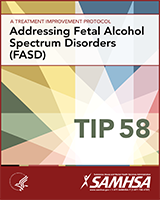NCBI Bookshelf. A service of the National Library of Medicine, National Institutes of Health.
Center for Substance Abuse Prevention (US). Addressing Fetal Alcohol Spectrum Disorders (FASD). Rockville (MD): Substance Abuse and Mental Health Services Administration (US); 2014. (Treatment Improvement Protocol (TIP) Series, No. 58.)
This Treatment Improvement Protocol (TIP) is designed to assist not only substance abuse treatment and mental health counselors in providing FASD-informed services, but also the clinical supervisors and administrators who support the work of these professionals. The need for a TIP that addresses FASD prevention and intervention for these settings is clear:
- Individuals with an FASD experience higher rates of substance abuse and mental health issues than the general population (Streissguth et al., 1996; Streissguth & O'Malley 2000; Astley 2010). In addition, individuals with an FASD exhibit higher rates of life problems commonly encountered in substance abuse and mental health treatment populations, including higher risk of suicide (Huggins et al., 2008), exposure to multiple traumas throughout the lifespan (Henry, Sloane, & Black-Pond, 2007; Greenbaum et al., 2009), homelessness (Fryer, McGee, Matt, Riley, & Mattson, 2007), and increased interaction with the criminal justice system (Streissguth et al., 1996).
- According to the 2009 National Survey on Drug Use and Health (NSDUH), 17.1 percent of women age 18 or over in the U.S. received mental health treatment or counseling in 2009, compared to only 9.2 of men in the same age group (Center for Behavioral Health Statistics and Quality [CBHSQ], 2010), while the Treatment Episode Data Set (TEDS) indicates that 33.0 percent of admissions to substance abuse treatment facilities in 2011 were female, more than half of whom (50.5 percent) indicated alcohol as a primary, secondary, or tertiary substance of abuse (CBHSQ, 2013). In addition, an in-depth study of 80 birth mothers of children with FAS revealed that 97 percent had from 1 to 9 mental disorders, and the subset that successfully achieved abstinence was significantly more likely to have received treatment for their mental disorders than the subset who did not achieve abstinence (Astley et al., 2000b).
Thus, these settings are 1) likely to see a high prevalence of individuals with an FASD (and/or their parents/caregivers), and 2) provide an ideal environment for conducting interventions with women of childbearing age to prevent additional incidences of FASD.
The methods and techniques presented in this TIP are appropriate for clients in all stages of recovery and treatment. However, this TIP is not meant to create a ‘one-stop shop’ for FASD-informed services. An FASD is not a simple category that can be addressed with a simple, categorical response; the disorders in this spectrum cannot be cured, and clients with an FASD need specialized treatment from a variety of healthcare professionals to function at their maximum potential. At the same time, when treating a substance abuse or mental health issue with a client, the counselors' role is to:
- Be able to recognize when a client is exhibiting a co-occurring issue (such as an FASD) that can impede treatment success;
- Address how the physical, cognitive, and behavioral manifestations of that issue interact with treatment; and
- Develop a collaborative treatment relationship with the other healthcare and social service professionals who do—or potentially can—provide assistance to the client to maximize that person's potential for success, both in and outside treatment.
Like any other co-occurring issue in treatment—trauma, homelessness, etc.—addressing FASD is a fundamental step toward helping the whole person and ensuring that he or she does not encounter treatment barriers.
Note: This Implementation Guide follows two tracks; FASD prevention, and FASD intervention. This is because this TIP promotes 1) the screening of all women of childbearing age (whether pregnant or not) in all behavioral health settings for alcohol consumption, to help prevent future incidences of FASD [FASD prevention], and 2) the development of staff skills in recognizing individuals who have or may have an FASD, to be able to more effectively tailor treatment to their needs [FASD intervention]. In Part 1 of this TIP, these topics are treated separately. In the Implementation Guide, they are discussed together, since they each represent organizational change and the core processes involved in making such changes within a program overlap significantly.
- Introduction - Addressing Fetal Alcohol Spectrum Disorders (FASD)Introduction - Addressing Fetal Alcohol Spectrum Disorders (FASD)
- cytochrome oxidase subunit 1, partial (mitochondrion) [Praon volucre]cytochrome oxidase subunit 1, partial (mitochondrion) [Praon volucre]gi|1063182011|gb|AON92107.1|Protein
- cytochrome oxidase subunit 1, partial (mitochondrion) [Aphidiinae sp. BOLD:AAE71...cytochrome oxidase subunit 1, partial (mitochondrion) [Aphidiinae sp. BOLD:AAE7186]gi|229426048|gb|ACQ64407.1|Protein
Your browsing activity is empty.
Activity recording is turned off.
See more...
